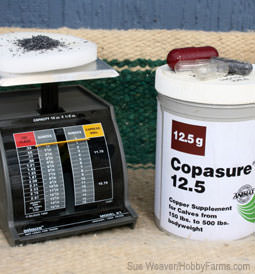
 Photo by Sue Weaver If your goat has a copper deficiency, you can prepare a bolus and administer with a pet piller. |
I have another question to answer! This one is from a goat named Elmo:
“Hi Martok, I’m a Pygmy goat wether and my brown coat is rough and turning light orange on my legs and tail! My mom suspects a copper deficiency, but I frequently nibble on a low-protein, loose mineral for goats, which contains copper. Mom knows that too much copper is dangerous, so she is hesitant to give me more. Any advice? I sure would like to have my coat looking shiny and dark brown again.”
Copper is an essential micronutrient, so we goats need it but only in tiny amounts. In fact, all mammals need copper, even humans! Amounts needed vary by species, breed, age, how healthy we are, the levels of other minerals we consume and even the levels of feed additives in our diets. Symptoms of copper toxicity in goats include weakness, panting, jaundice, dark-red or brown urine, abortion in does and even death. This is serious stuff, so ask your Mom to talk with your veterinarian, a nutritionist at your state veterinary college or your county extension agent before adding more copper to your diet.
Your orange coloring is, however, one of the symptoms of copper deficiency in goats. That’s because copper is essential for the production of melanin, an enzyme involved with hair pigmentation. Low melanin levels cause faded color around eyes and a red tinge to dark-colored coats. Other symptoms include rough coats, anemia, hoof problems, winter hair that doesn’t shed on time, less chance for does to get pregnant and getting sick more easily
 Photo by Sue Weaver Copper oxide wire particles can be given in a bolus to a copper-deficient goat. |
A good, loose mineral formulated specifically for goats usually gives us enough copper. When it doesn’t, goat owners sometimes dose their goats with COWP. COWP stands for copper oxide wire particles, short pieces of copper wire enclosed in gel capsules designed to dissolve in a goat’s abomasum, the fourth compartment of his stomach. These particles slowly disintegrate, releasing copper into the goat’s system over a period of time, usually four to six months. Because the only commercially available product, Copasure, is packaged for cattle and calves, goat owners use ready-made boluses and repackage COWP in gelatin capsules, usually at the rate of 1 gram of COWP per 22 pounds of goat.
Copper boluses are especially important when people keep both sheep and goats. Sheep need copper but usually get enough through their diets. Sheep that consume bagged feed or mineral products formulated for goats retain excess copper in their livers. This builds up and can eventually kill them, so farmers who have both sheep and goats do one of several things:
- We goats are good climbers, but most sheep aren’t, so it’s usually safe to put goat minerals where goats can hop up on something to eat them but sheep can’t. The disadvantage is that the sheep need sheep minerals down at their own level and if goats eat that instead of their goat minerals, they might not ingest enough copper.
- They separate their sheep at night and provide species-specific minerals in each group’s sleeping area.
- They put out sheep minerals for everyone and copper bolus their goats two or three times a year.
Our Mom and Dad do No. 2 and 3. Mom prepares boluses by opening calf-size Copasure boluses and weighing the COWP on a postal scale, then packing the particles in appropriately-sized empty gelatin capsules from the health-food store. They give us our boluses using a pet piller. It’s not much fun for us but it works!
I cannot emphasize enough working with a livestock expert on your goat’s nutrition plan. We goats are a lot of fun to have around, and you don’t want to do anything dangerous that could make us sick!
Ask Martok!
Do you have a livestock or wildlife question you want me to answer? Send me your question!




